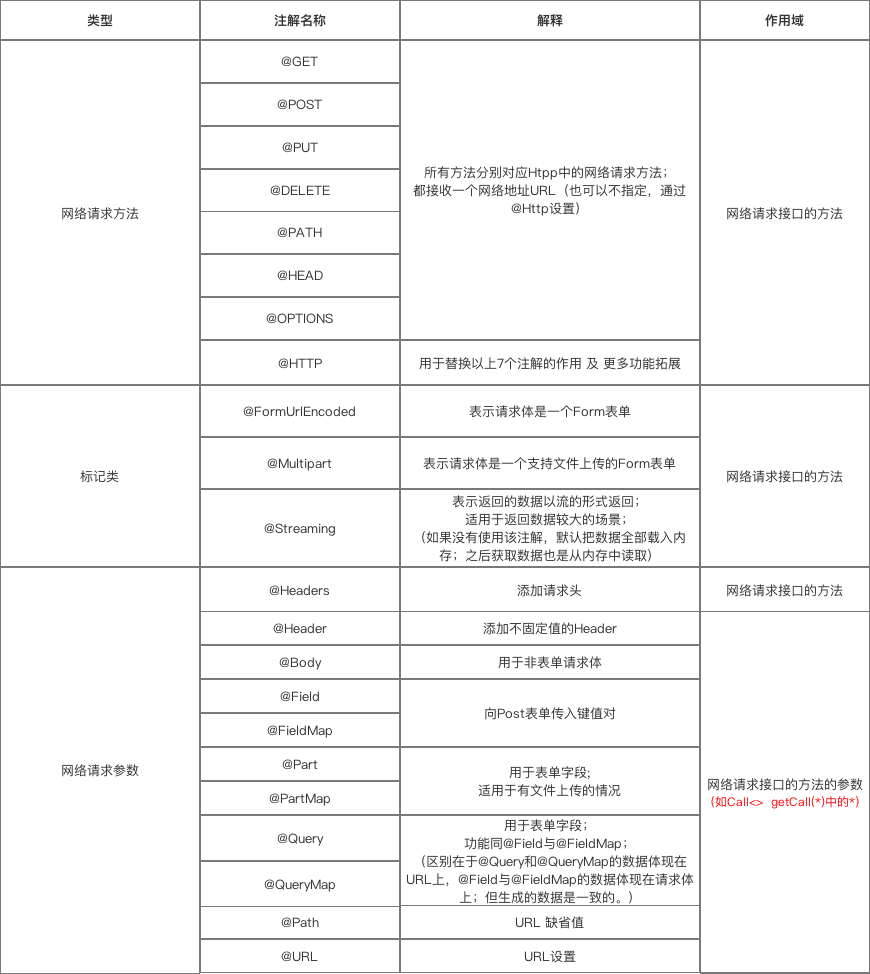Android 网络框架 Retrofit2
概述
Retrofit是一个OkHttp网络请求框架的封装库,Retrofit通过注解配置网络参数,可以按照我们的规则去构造实际的HTTP请求,能够灵活设置URL、头部、请求体、返回值等,是目前最优雅的一个网络框架。
添加依赖
implementation 'com.squareup.retrofit2:retrofit:2.2.0' implementation 'com.squareup.retrofit2:adapter-rxjava2:2.2.0'//添加对RxJava的支持
implementation 'com.squareup.retrofit2:converter-gson:2.1.0' //添加Json数据的支持 <uses-permission android:name="android.permission.INTERNET"/>//网络请求必要的权限
Retrofit基本使用三部曲
创建实例
Retrofit retrofit = new Retrofit.Builder()
.baseUrl("http://id1.option****.cc:***1/")//Retrofit2 的baseUlr 必须以 /(斜线) 结束
.build();
RetrofitService service = retrofit.create(RetrofitService.class);//创建接口的代理对象
定义接口
public interface RetrofitService {
@GET("/pursuit/getPursuitInfo")
Call<ResponseBody> getBlog(@Query("id") int id);
@GET("/pursuit/getPursuitInfo/{id}")
Call<ResponseBody> getBlog2(@Path("id") String id);
}
创建 同步/异步 回调
//异步的回调
Call<ResponseBody> call = service.getBlog(123);
call.enqueue(new Callback<ResponseBody>() {
@Override
public void onResponse(Call<ResponseBody> call, retrofit2.Response<ResponseBody> response) {
try {
Log.i("返回信息",response.body().string()+"");//打印返回信息
} catch (IOException e) {
e.printStackTrace();
} }
@Override
public void onFailure(Call<ResponseBody> call, Throwable t) {
t.printStackTrace();//错误信息
}
}); /*同步的回调,如果不是在一个Activity或者一个Fragment中去执行,那么也就意味着,你可以不需要开启子线程去执行网络请求。如果是在主线程,就必须开启子线程来进行同步请求
使用call.execute()同步请求,只能调用一次。如果要多次使用这个方法,需要 call.clone()重新生成新的Call实例*/ new Thread(new Runnable() {
@Override
public void run() {
try {
retrofit2.Response<ResponseBody> response = call.execute();
response.body();
} catch (IOException e) {
e.printStackTrace();
}
}
});
HTTP协议中的常用请求
GET: 请求指定的页面信息,以?分割URL和传输数据,参数之间以&相连,最多只能是1024字节,并返回实体主体,该操作用于获取信息而非修改信息
HEAD: 只请求页面的首部。
POST: POST表示可能修改变服务器上的资源的请求,.POST的安全性要比GET的安全性高
PUT: 从客户端向服务器传送的数据取代指定文档的内容。
Retrofit注解的重点详解
注解汇总
需要理解并灵活搭配使用

基本请求
Responsebody是Retrofit网络请求回来的原始数据类。get方式可以在url后面串联
@Path注解用于替换请求参数,@Query注解相当于url后面的串联,他们可以同时使用
请看下面第三种表达式:
@GET("/pursuit/getPursuitInfo?id=123")
Call<ResponseBody> getCall();
@POST("/pursuit/getPursuitInfo")
Call<ResponseBody> getBlog(@Query("id") int id);
@GET("/pursuit/getPursuitInfo/{id}")
Call<ResponseBody> getBlog2(@Path("id") String id);
自定义请求
需要用到@HTTP注解
/* method:网络请求的方法,注意大小写
* path:网络请求地址路径
* hasBody:是否有请求体
* {id} 表示是一个变量*/
@HTTP(method = "GET", path = "/pursuit/getPursuitInfo/{id}", hasBody = false)
Call<ResponseBody> getCall(@Path("id") int id);
请求体非Form表单
@Body是Post方式提交非Form的表单
@POST("/pursuit/getPursuitInfo")
Observable<String> getPursuitInfo(@Body User user);
请求体是Form表单
如果请求的Form表单,需要用@FormUrlEncoded标注,@Field注解用于表单字段,它和@FieldMap都需要@FormUrlEncoded配合使用
@Field和@Query都是表单字段,@FieldMap和@Query都是批量增加表单的提交域。区别如上图,一个拼接在URL上适用于get方式,一个体现在请求体上试用于post方式,区分好使用场景。
@POST("/pursuit/getPursuitInfo")
@FormUrlEncoded
Call<ResponseBody> testFormUrlEncoded1(@Field("username") String name, @Field("age") int age);
设置请求头
两种请求头的,@Header用于添加不固定的请求头,作用于方法的参数。@Headers用于添加固定的请求头,作用于方法
@Headers("Authorization: authorization")
@GET("/pursuit/getPursuitInfo")
Call<ResponseBody> getUser();
@GET("/pursuit/getPursuitInfo")
Call<ResponseBody> getUser(@Header("Authorization") String authorization);
动态替换URL
用@Url替换已经设置的baseUrl
@GET
public Call<ResponseBody> profilePicture(@Url String url);
图片上传
@POST("user/updateAvatar.do")
@Multipart
Call<ResponseBody> upload(@Part("upload1\"; filename=\"image1.jpg\"") RequestBody imgs );
文件上传
发送form-encoded的数据,用于有文件上传的场景时要用 @Multipart 注解,@Part和@PartMap适用于有文件上传的情况
@POST("mobile/upload")
@Multipart
Call<ResponseBody> upload(@Part MultipartBody.Part file);
文件上传相关阅读
※以上就是所有参数注解的用法,需要实践灵活试用。
Retrofit与Gson
添加对gson的支持
Retrofit retrofit = new Retrofit.Builder()
.baseUrl("http://id1.option****.cc:***1/")//Retrofit2 的baseUlr 必须以 /(斜线) 结束
.addConverterFactory(GsonConverterFactory.create())//添加对gson的支持
.build();
建立接口,返回Bean
public interface PostRoute {
@Headers({"Content-Type: application/json","Accept: application/json"})//需要添加头
@POST("api/FlyRoute/Add")
Call<FlyRouteBean> postFlyRoute(@Body RequestBody route);//传入的参数为RequestBody
}
将Bean转换成json字符串
FlyRouteBean flyRouteBean=new FlyRouteBean();
flyRouteBean=initdata(flyRouteBean);//根据Bean类初始化一个需要提交的数据类
Gson gson=new Gson();
String route= gson.toJson(flyRouteBean);//通过Gson将Bean转化为Json字符串形式
提交json数据
RequestBody body=RequestBody.create(okhttp3.MediaType.parse("application/json; charset=utf-8"),route); //将json转换成RequestBody请求体
Call<FlyRouteBean> call=postRoute.postFlyRoute(body);//提交
Retrifit与RxJava
引入RxJava
compile 'io.reactivex.rxjava2:rxjava:2.1.0'
compile 'io.reactivex.rxjava2:rxandroid:2.0.1'
添加对RxJava的支持
Retrofit retrofit = new Retrofit.Builder()
.baseUrl("http://id1.option****.cc:***1/")//Retrofit2 的baseUlr 必须以 /(斜线) 结束
.addConverterFactory(GsonConverterFactory.create())//添加对gson的支持
.client(client)//添加okhttp的支持
.addCallAdapterFactory(RxJava2CallAdapterFactory.create())//添加对RxJava的支持
.build();
连接超时与开启okhttp的日志打印
private static final OkHttpClient client = new OkHttpClient.Builder().
addInterceptor(new HttpLoggingInterceptor().//开启日志信息
setLevel(HttpLoggingInterceptor.Level.BODY)).
connectTimeout(600, TimeUnit.SECONDS).//连接超时
readTimeout(600, TimeUnit.SECONDS).//读取超时
writeTimeout(600, TimeUnit.SECONDS).build();//写入超时
建立接口,返回Observable被观察者
@GET("top250")
Observable<MovieEntity> getTopMovie(@Query("start") int start, @Query("count") int count);
建立观察者
Observable<String> observable =service.getTopMovie(0, 10)
.subscribeOn(Schedulers.io())
.observeOn(AndroidSchedulers.mainThread())
.subscribe(new Observer<ResponseBody>() {
@Override
public void onSubscribe(Disposable d) { } @Override
public void onNext(ResponseBody responseBody) { } @Override
public void onError(Throwable e) { } @Override
public void onComplete() { }
});
Retrofit的简单封装
retrofit工具类
public class WebManager {
private static WebManager webManager;
private RetrofitService retrofitService;
public WebManager(Context context) {
Retrofit retrofit = new Retrofit.Builder()
.baseUrl(StaticConstant.HOST_PORT)//地址
.addConverterFactory(GsonConverterFactory.create())//添加gson支持
.client(client)//设置okhttp连接
.addCallAdapterFactory(RxJava2CallAdapterFactory.create())//添加RxJava的支持
.build();
retrofitService = retrofit.create(RetrofitService.class);
}
private static final OkHttpClient client = new OkHttpClient.Builder().
addInterceptor(new HttpLoggingInterceptor().//开启日志信息
setLevel(HttpLoggingInterceptor.Level.BODY)).
connectTimeout(600, TimeUnit.SECONDS).//连接超时
readTimeout(600, TimeUnit.SECONDS).//读取超时
writeTimeout(600, TimeUnit.SECONDS).build();//写入超时
//获取单例
public static WebManager getInstance(Context context){
if(webManager == null){
webManager = new WebManager(context);
}
return webManager;
}
//上传xx信息,使用@Field注解
public void postInfoField(Callback<ResponseBody> callback, String str){
retrofitService.getWarrant("queryApplicationForm",null,str)
.enqueue(callback);
}
//上传xx信息,使用@FieldMap注解
public void postInfoFieldMap(Callback<ResponseBody> callback, String num,String name){
Map<String, Object> map=new HashMap<>();
map.put("hotelCode",num);
map.put("hotelName",name);
retrofitService.getUnlicensedNum(map).enqueue(callback);
}
//上传xx信息,使用@Body 注解
public void postMultipartBody(Callback<ResponseBody> callback, String key,File file, String name){
MultipartBody.Builder builder= new MultipartBody.Builder().setType(MultipartBody.FORM);
if(file.exists()) {
builder.addFormDataPart("access_token", key);
builder.addFormDataPart("name", name);
builder.addFormDataPart("image", ImageUtil.imageToBase64(file.getPath()));
builder.addFormDataPart("image_type", "BASE64");
}
retrofitService.getUnlicensedCheck(builder.build()).enqueue(callback);
}
//上传xx信息,带文件,使用@Body 注解
public void postMultipartBody2(Callback<ResponseBody> callback, HotelInfo hotelInfo,String pictureCardPath,String picturePath){
Gson gson=new Gson();
String json= gson.toJson(hotelInfo);
File file = new File(pictureCardPath);
File file2 = new File(picturePath);
MultipartBody.Builder builder= new MultipartBody.Builder().setType(MultipartBody.FORM);
if(!file.exists()&&!file2.exists()) {
try {
builder.addFormDataPart("info", json);
builder.addFormDataPart("file",file.getName(), RequestBody.create(MediaType.parse("multipart/form-data"), file));
builder.addFormDataPart("file2",file2.getName(), RequestBody.create(MediaType.parse("multipart/form-data"), file2));
retrofitService.getHotelInfoFile(builder.build()).enqueue(callback);
} catch (Exception e) {
e.printStackTrace();
Log.i("WebManager","上传异常");
}
}
}
}
retrofit服务类
public interface RetrofitService {
@FormUrlEncoded
@POST("/Hotels/ExpressServlet")
Call<ResponseBody> getWarrant(@Field("type") String type, @Field("E_Code") String code,
@Field("applicationFormId") String id);
@FormUrlEncoded
@POST("Hotels/NoRegisterServlet")
Call<ResponseBody> getUnlicensedNum(@FieldMap Map<String,Object> fieldMap);
@POST("/rest/2.0/face/v3/person/verify")
Call<ResponseBody> getUnlicensedCheck(@Body MultipartBody builder);
@Headers("Connection: close" )
@POST("/Hotels/UploadFileImgServlet")
Call<ResponseBody> getHotelInfoFile(@Body MultipartBody builder);
}
RxJava相关阅读
Retrofit代码混淆配置
-dontwarn retrofit.**
-keep class retrofit.** { *; }
-keepattributes Signature
-keepattributes Exceptions
Android 网络框架 Retrofit2的更多相关文章
- Android网络框架Volley(体验篇)
Volley是Google I/O 2013推出的网络通信库,在volley推出之前我们一般会选择比较成熟的第三方网络通信库,如: android-async-http retrofit okhttp ...
- Android网络框架Volley(实战篇)
之前讲了ym—— Android网络框架Volley(体验篇),大家应该了解了volley的使用,接下来我们要看看如何把volley使用到实战项目里面,我们先考虑下一些问题: 从上一篇来看 mQu ...
- Android网络框架-Volley实践 使用Volley打造自己定义ListView
这篇文章翻译自Ravi Tamada博客中的Android Custom ListView with Image and Text using Volley 终于效果 这个ListView呈现了一些影 ...
- Android网络框架Volley
Volley是Google I/O 2013推出的网络通信库,在volley推出之前我们一般会选择比较成熟的第三方网络通信库,如: android-async-http retrofit okhttp ...
- ym—— Android网络框架Volley(终极篇)
转载请注明本文出自Cym的博客(http://blog.csdn.net/cym492224103).谢谢支持! 没看使用过Volley的同学能够,先看看Android网络框架Volley(体验篇)和 ...
- Android网络框架之Retrofit + RxJava + OkHttp 变化的时代
1.什么是Retrofit框架? 它是Square公司开发的现在非常流行的网络框架,所以我们在导入它的包的时候都可以看到这个公司的名字,目前的版本是2. 特点: 性能好,处理快,使用简单,Retrof ...
- Android网络框架源码分析一---Volley
转载自 http://www.jianshu.com/p/9e17727f31a1?utm_campaign=maleskine&utm_content=note&utm_medium ...
- 【从0到1】android网络框架的选型参考
项目会使用到 socket tcp 级的网络访问,想选取一个使用较成熟异步网络框架, 提到的网络框架: 1. volley, 2. xutils. 3. android 4. netty, 5. mi ...
- Android 网络框架Volley的使用
Volley简介 在平时的开发过程中,我们的应用几乎总是在和网络打交道, 在android下的网络编程一般都是基于Http协议的 ,常见的是HttpURLConnection和HttpClient 两 ...
随机推荐
- 一文读懂四种常见的XML解析技术
之前的文章我们讲解了<XML系列教程之Schema技术_上海尚学堂java培训技术干货><XML的概念.特点与作用.XML申明_上海Java培训技术干货>,大家可以点击回顾一下 ...
- Go接口interface
目录 接口是什么? interface类型 空接口(interface{}) interface函数参数 interface变量存储的类型 类型断言 嵌入interface 接口是什么? Go 语言不 ...
- [Java]LeetCode297. 二叉树的序列化与反序列化 | Serialize and Deserialize Binary Tree
Serialization is the process of converting a data structure or object into a sequence of bits so tha ...
- [Swift]LeetCode478. 在圆内随机生成点 | Generate Random Point in a Circle
Given the radius and x-y positions of the center of a circle, write a function randPoint which gener ...
- nfs服务启动失败:Failed to start NFS status monitor for NFSv2/3 locking..
今天碰到个问题,服务器重启后,nfs服务就启动不了了,关闭都关不了.查看系统日志报下面的错: Aug 10 17:08:53 prod-r3-slt-s-01 systemd: Started Pre ...
- [Abp 源码分析]三、依赖注入
0.简要介绍 在 Abp 框架里面,无时无刻不存在依赖注入,关于依赖注入的作用与好处我就不在这里多加赘述了,网上有很多解释的教程.在 [Abp 源码分析]一.Abp 框架启动流程分析 里面已经说过,A ...
- java代码之美(4)---guava之Immutable(不可变)集合
Immutable(不可变)集合 一.概述 guava是google的一个库,弥补了java语言的很多方面的不足,很多在java8中已有实现,暂时不展开.Collections是jdk提供的一个工具类 ...
- SpringCloud(1)---基于RestTemplate微服务项目案例
基于RestTemplate微服务项目 在写SpringCloud搭建微服务之前,我想先搭建一个不通过springcloud只通过SpringBoot和Mybatis进行模块之间额通讯.然后在此基础上 ...
- 从锅炉工到AI专家(11)(END)
语音识别 TensorFlow 1.x中提供了一个语音识别的例子speech_commands,用于识别常用的命令词汇,实现对设备的语音控制.speech_commands是一个很成熟的语音识别原型, ...
- 【Python3爬虫】网易云音乐爬虫
此次的目标是爬取网易云音乐上指定歌曲所有评论并生成词云 具体步骤: 一:实现JS加密 找到这个ajax接口没什么难度,问题在于传递的数据,是通过js加密得到的,因此需要查看js代码. 通过断掉调试可以 ...
